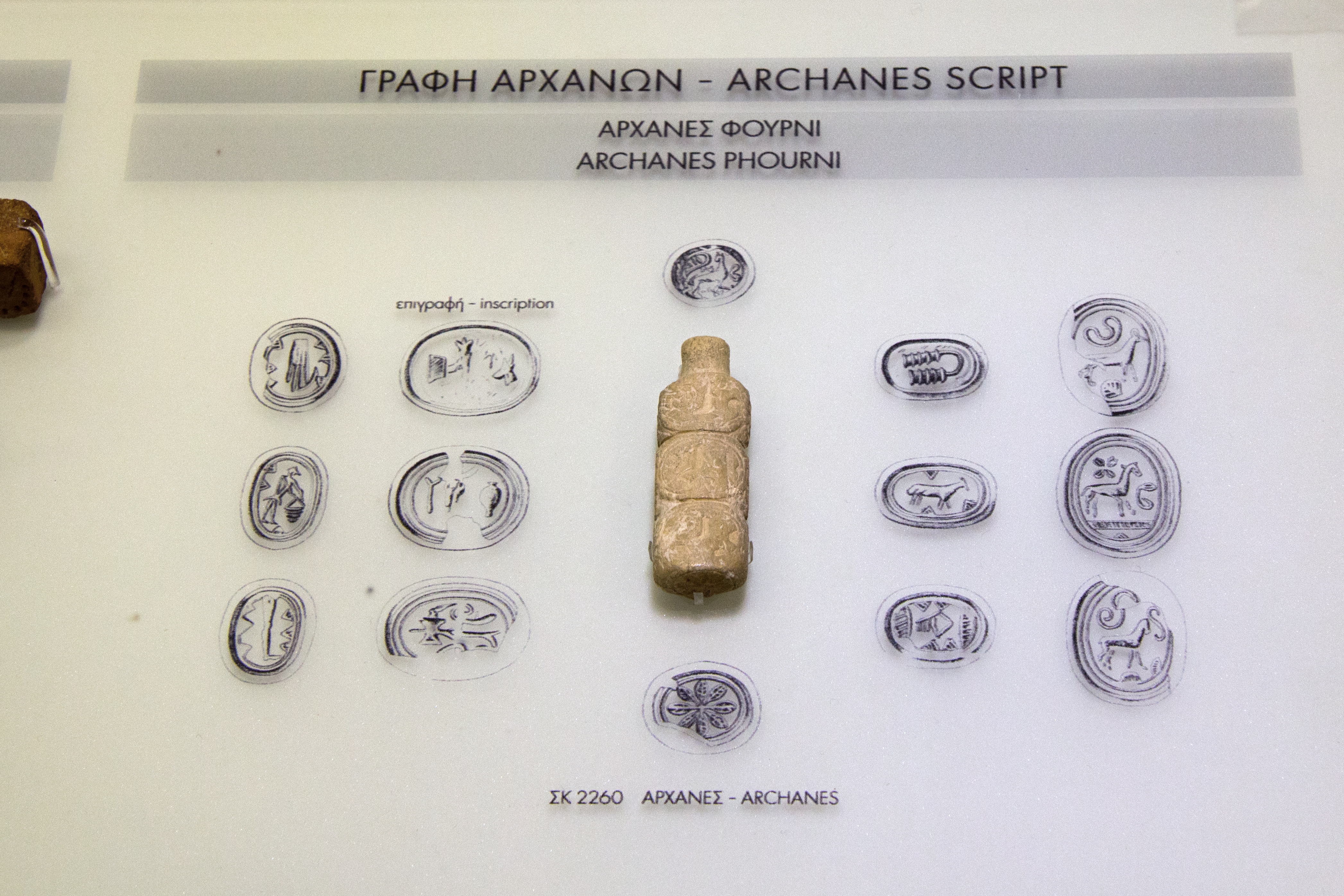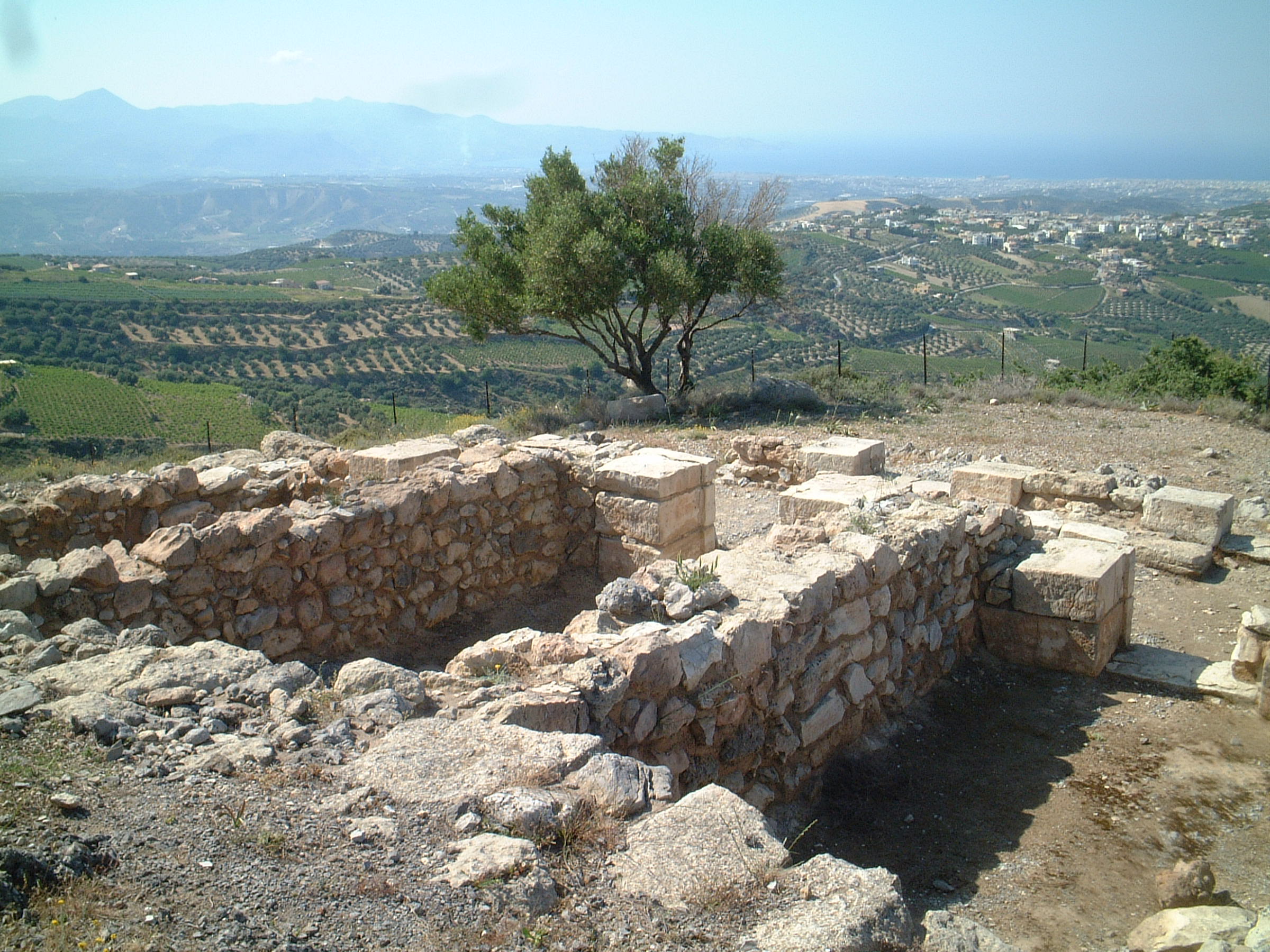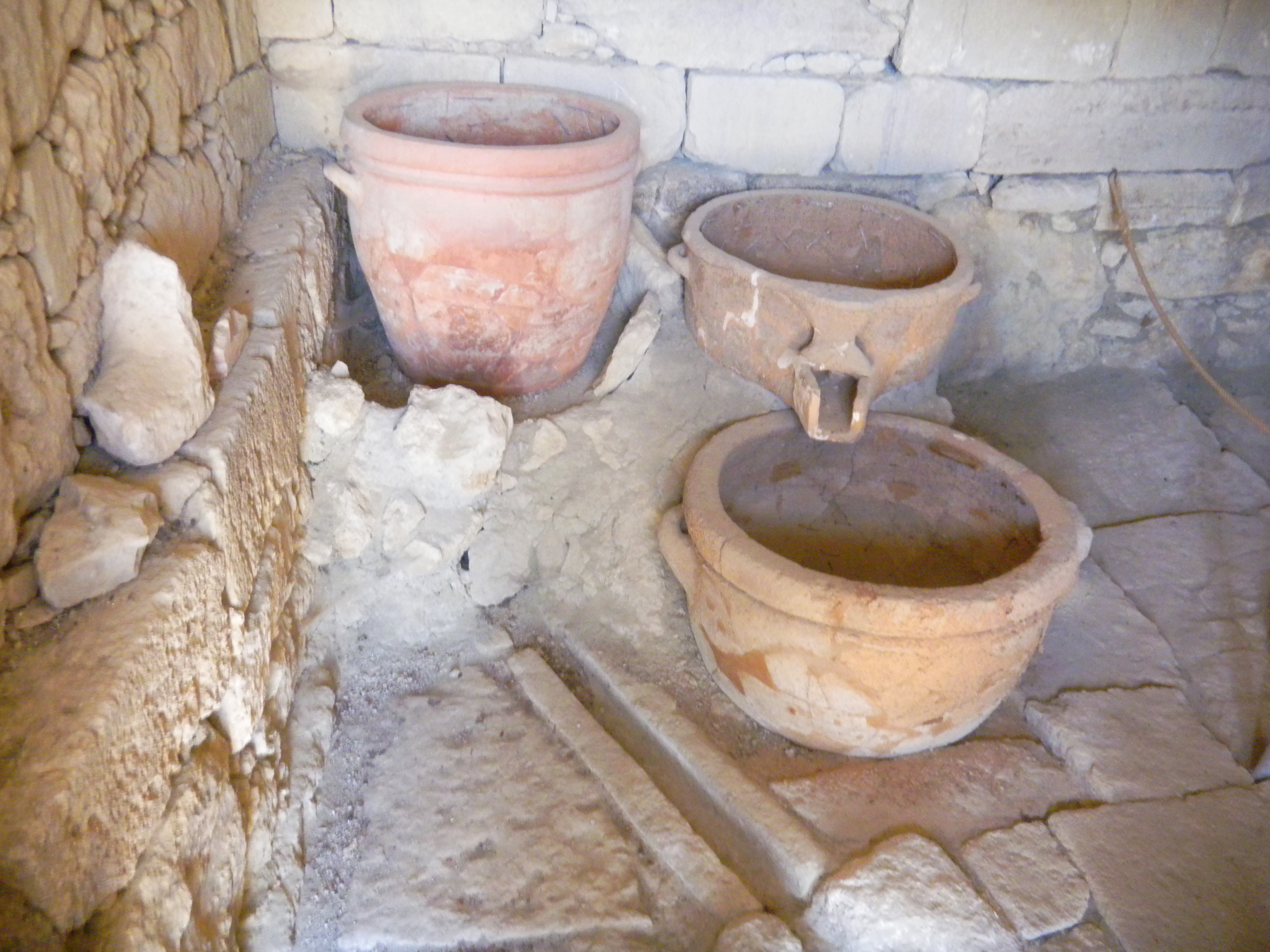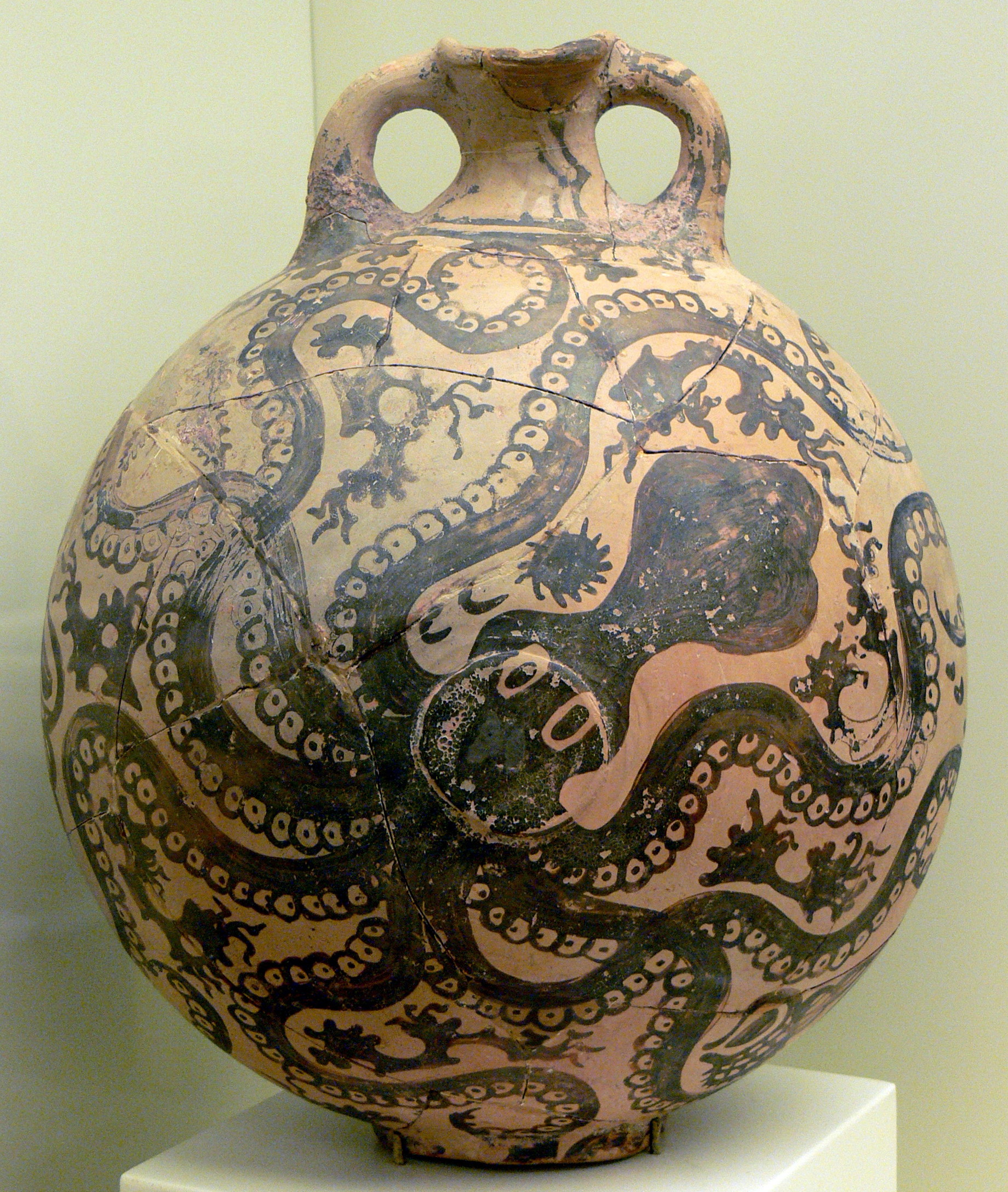|
Archanes
Archanes ( el, Αρχάνες, Godart & Olivier abbreviation: ARKH) is a former municipality in the Heraklion regional unit, Crete, Greece. Since the 2011 local government reform it is part of the municipality Archanes-Asterousia, of which it is a municipal unit. The municipal unit has an area of . Population 5,042 (2011). It is also the archaeological site of an ancient Minoan settlement in central Crete. The discovery of ancient roads leading from Archanes to Juktas, Anemospilia, Xeri Kara and Vathypetro indicate that Archanes was an important hub in the region during Minoan times. Archaeological evidence indicates that ancient Archanes spread out over the same area as the modern town of Archanes. Archaeology In 1912, Xanthoudides noted the importance of Archanes, but Sir Arthur Evans was the first to characterize the site as palatial, declaring that Archanes was likely a Summer Palace for the Knossos kings. Spyridon Marinatos and N. Platon excavated minor areas in the reg ... [...More Info...] [...Related Items...] OR: [Wikipedia] [Google] [Baidu] |
Archanes-Asterousia
Archanes–Asterousia ( el, Αρχάνες-Αστερούσια) is a municipality in Heraklion regional unit, Crete, Greece. The seat of the municipality is the village Peza. The municipality has an area of 337.137 km2. Municipality The municipality Archanes–Asterousia was formed at the 2011 local government reform by the merger of the following 3 former municipalities, that became municipal units: *Archanes *Asterousia *Nikos Kazantzakis Nikos Kazantzakis ( el, ; 2 March ( OS 18 February) 188326 October 1957) was a Greek writer. Widely considered a giant of modern Greek literature, he was nominated for the Nobel Prize in Literature in nine different years. Kazantzakis's no ... References Municipalities of Crete Populated places in Heraklion (regional unit) {{Crete-geo-stub ... [...More Info...] [...Related Items...] OR: [Wikipedia] [Google] [Baidu] |
Yannis Sakellarakis
Yannis A. Sakellarakis ( el, Γιάννης Α. Σακελλαράκης; 1936 – October 28, 2010) was a prominent Greek archaeologist who specialized in Minoan Prehistory. Career Sakellarakis studied archaeology at the University of Athens (Dept of History and Archaeology) and later pursued graduate studies at Heidelberg University, where he was awarded a doctorate in 1969. Sakellarakis taught at the Universities of Heidelberg, Hamburg and Athens. He served as the curator (1963-68) and then director (1980-87) of Heraklion Archaeological Museum in Crete and curator (1970-80) and later deputy director (1987-94) of the National Archaeological Museum in Athens. He excavated sites at Archanes, Kythira and Mount Ida. Sakellarakis attracted international attention in 1979, when, while excavating the hill of Anemospilia in Archanes with his wife Efi Sapouna-Sakellaraki, he discovered evidence for human sacrifice by the Minoans. Another major discovery took place in 1982, when Sak ... [...More Info...] [...Related Items...] OR: [Wikipedia] [Google] [Baidu] |
Troullos
Troullos, also known as Trullos, is the archaeological site of an ancient Minoan settlement on Crete. The Troullos site is the easternmost section of the ancient settlement at Archanes. The king of Knossos is believed to have maintained a summer palace there. Archaeology Trullos was first excavated by Sir Arthur Evans, later by Spyridon Marinatos and most recently by J. and E. Sakellarakis. The site was in use from Middle Minoan II until late Minoan I. Architecture * Paved courtyards * Middle Minoan II, Middle Minoan III and Late Minoan I multiple-storeyed buildings * Late Minoan I house, including a light-well * Clay-brick partition walls (building internals) * Ashlar walls (building internals) * Wall-paintings on plaster Artifacts Among the movable artifacts at Troullos: * Polychrome Kamares ware * Terracotta figurines * Tripod offering tables * Beak-spouted jugs * The Archanes Ladle, a translucent alabaster ladle with Linear A inscriptions labelled TLZa1 by Godart an ... [...More Info...] [...Related Items...] OR: [Wikipedia] [Google] [Baidu] |
Godart & Olivier
Cretan hieroglyphs are a hieroglyphic writing system used in early Bronze Age Crete, during the Minoan era. They predate Linear A by about a century, but the two writing systems continued to be used in parallel for most of their history. , they are undeciphered. Corpus As of 1989, the corpus of Cretan hieroglyphic inscriptions included two parts: * Seals and sealings, 150 documents with 307 sign-groups, using 832 signs in all. * Other documents on clay, 120 documents with 274 sign-groups, using 723 signs. More documents, such as those from the Petras deposit, have been published since then. A four sided prism was found in 2011 at Vrysinas in western Crete. These inscriptions were mainly excavated at four locations: *"Quartier Mu" at Malia ( Middle Minoan II period = MM II) *Malia palace (MM III) *Knossos (MM II or III) *the Petras deposit (MM IIB), excavated starting in 1995 and published in 2010. The first corpus of signs was published by Evans in 1909. The current corpus ... [...More Info...] [...Related Items...] OR: [Wikipedia] [Google] [Baidu] |
Anemospilia
Anemospilia ( ell, τα Ανεμόσπηλια) is the archaeological site of an ancient Minoan temple on Crete. Geography The temple is located on the northern end of Mount Juktas. Modern Heraklion can be seen from the site. The site is in the country side near Arkhanes, about 7 kilometers from Knossos on the Island of Crete. It was on a hillside facing north towards the palace complexes of Knossos. Various factors made archaeologists conclude that it was a temple. The site is in the countryside, Anemospilia means 'caves of the wind'. It is in the foothills of Mount Juktas, the legendary burial place of Zeus. Archaeology Anemospilia was first excavated in 1979 by the Greek archaeologist Yannis Sakellarakis. The temple was destroyed by earthquake and fire around 1700 BC, about the same time as the destruction of the first palaces. The temple was found in a ruined state with stone walls only reaching hip height. Traces of ash and charcoal were found on the ground, and from this, ... [...More Info...] [...Related Items...] OR: [Wikipedia] [Google] [Baidu] |
Heraklion (regional Unit)
Heraklion ( el, Περιφερειακή ενότητα Ηρακλείου) is one of the four regional units of Crete. The capital is the city of Heraklion. Geography The regional unit of Heraklion borders on the regional units of Rethymno to the west and Lasithi to the east. Farmlands are situated in the central and the northern parts, at the coast and in valleys. The mountains dominate the rest of the regional unit, notably the south. The main mountains are parts of Ida or Idi Mountains to the west and Asterousia in the south. The regional unit includes the island of Dia to the north. Except for the mountains which receive mild to cool winters unlike northern Greece, the warm to hot Mediterranean climate dominates the regional unit. Ancient history Within the Heraklion regional unit's boundaries are a number of significant Neolithic and Minoan settlements, most notably the ancient palace complexes of Knossos and Phaistos. While both archaeological sites evince Neolithi ... [...More Info...] [...Related Items...] OR: [Wikipedia] [Google] [Baidu] |
Vathypetro
Vathypetro ( el, Βαθύπετρο) is an archaeological site, four kilometres south of the town of Archanes on Crete (Greece). It contains some of the oldest wine presses in the world. Excavations began in 1949 by the Greek archaeologist Spyridon Marinatos Spyridon Nikolaou Marinatos ( el, Σπυρίδων Νικολάου Μαρινάτος; November 4, 1901 – October 1, 1974) was a Greek archaeologist, best known for leading excavations at Akrotiri on Santorini (1967–74), where he died and i .... The estate contains a manor house or villa which had a prominent role in the rural region around Archanes. The complex consists of several buildings, courtyards and workshop spaces. Next to the individual houses is the Minoan wine press (wine press), a plant for the production of olive, a Minoan kiln and ceramics, and the remains of an ancient pottery workshop. References External links * http://www.minoancrete.com/vathypetro.htm Heraklion (regional unit) Minoan sites ... [...More Info...] [...Related Items...] OR: [Wikipedia] [Google] [Baidu] |
Minoan Civilization
The Minoan civilization was a Bronze Age Aegean civilization on the island of Crete and other Aegean Islands, whose earliest beginnings were from 3500BC, with the complex urban civilization beginning around 2000BC, and then declining from 1450BC until it ended around 1100BC, during the early Greek Dark Ages, part of a wider bronze age collapse around the Mediterranean. It represents the first advanced civilization in Europe, leaving behind a number of massive building complexes, Minoan art, sophisticated art, and writing systems. Its economy benefited from a network of trade around much of the Mediterranean. The civilization was rediscovered at the beginning of the 20th century through the work of British archaeologist Sir Arthur Evans. The name "Minoan" derives from the mythical Minos, King Minos and was coined by Evans, who identified the site at Knossos with the labyrinth of the Minotaur. The Minoan civilization has been described as the earliest of its kind in Europe, and his ... [...More Info...] [...Related Items...] OR: [Wikipedia] [Google] [Baidu] |
Minoan Pottery
Minoan pottery has been used as a tool for dating the mute Minoan civilization. Its restless sequence of quirky maturing artistic styles reveals something of Minoan patrons' pleasure in novelty while they assist archaeologists in assigning relative dates to the strata of their sites. Pots that contained oils and ointments, exported from 18th century BC Crete, have been found at sites through the Aegean islands and mainland Greece, on Cyprus, along coastal Syria and in Egypt, showing the wide trading contacts of the Minoans. The pottery consists of vessels of various shapes, which as with other types of Ancient Greek pottery may be collectively referred to as "vases", and also "terracottas", small ceramic figurines, models of buildings and some other types. Some pieces, especially the cups of rhyton shape, overlap the two categories, being both vessels for liquids but essentially sculptural objects. Several pottery shapes, especially the rhyton cup, were also produced in soft st ... [...More Info...] [...Related Items...] OR: [Wikipedia] [Google] [Baidu] |
Knossos
Knossos (also Cnossos, both pronounced ; grc, Κνωσός, Knōsós, ; Linear B: ''Ko-no-so'') is the largest Bronze Age archaeological site on Crete and has been called Europe's oldest city. Settled as early as the Neolithic period, the name Knossos survives from ancient Greek references to the major city of Crete. The palace of Knossos eventually became the ceremonial and political centre of the Minoan civilization and culture. The palace was abandoned at some unknown time at the end of the Late Bronze Age, c. 1380–1100 BC; the reason is unknown, but one of the many disasters that befell the palace is generally put forward. In the First Palace Period (around 2000 BC), the urban area reached a size of as many as 18,000 people. Spelling The name Knossos was formerly latinization of names, Latinized as Cnossus or Cnossos and occasionally Knossus, Gnossus, or Gnossos but is now almost always written Knossos. Neolithic period The site of Knossos has had a very long history ... [...More Info...] [...Related Items...] OR: [Wikipedia] [Google] [Baidu] |
Kairatos River
The Kairatos ( el, Καίρατος, la, Caeratus) is a natural watercourse on the island of Crete in Greece. In the Minoan era, aqueducts diverted water to Kephala hill from spring water sources at Archanes, which springs are the headwaters of the Kairatos River; in fact, the Bronze Age palace of Knossos lay upon the gently sloping banks of the Kairatos. The Kairatos runs east of Knossos and flows into the Aegean Sea in the Katsampas area, 1.5 km east of the city center of Heraklion Heraklion or Iraklion ( ; el, Ηράκλειο, , ) is the largest city and the administrative capital of the island of Crete and capital of Heraklion regional unit. It is the fourth largest city in Greece with a population of 211,370 (Urban A .... References [...More Info...] [...Related Items...] OR: [Wikipedia] [Google] [Baidu] |
Archaeological Society Of Athens
The Archaeological Society of Athens (Greek: Εν Αθήναις Αρχαιολογική Εταιρεία) is an independent learned society. Also termed the Greek Archaeological Society, it was founded in 1837 by Konstantinos Bellios, just a few years after the establishment of the modern Greek State, with the aim of encouraging archaeological excavations, maintenance, care and exhibition of antiquities in Greece. The Archaeological Society of Athens work in excavation and funding of archaeological endeavours are extensive. For example, the society helped discover new epigraphical evidence associated with the sanctuary of the goddess Demeter within Eleusis. In addition to this, they provided plans of the prehistoric settlement of Thorikos to help uncover ancient ceramic material. History The Archaeological Society of Athens is an independent archaeological organisation of scholars, historians, and academics founded in 1837. It was built to relocate, restore, and re-erecting ... [...More Info...] [...Related Items...] OR: [Wikipedia] [Google] [Baidu] |





.jpg)
